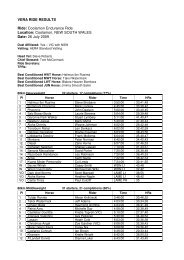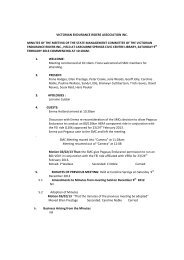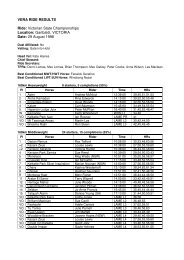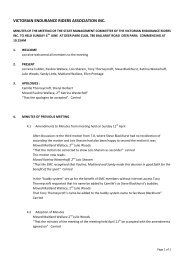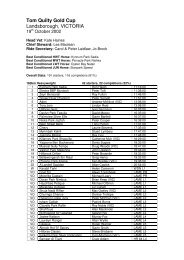Common Lameness Problems In Endurance Horses - Australian ...
Common Lameness Problems In Endurance Horses - Australian ...
Common Lameness Problems In Endurance Horses - Australian ...
Create successful ePaper yourself
Turn your PDF publications into a flip-book with our unique Google optimized e-Paper software.
The progressive deterioration and associated pain of diminished blood supply and internal<br />
fluid accumulation, results in avoidance of heel contact, with development of higher<br />
and contracted heels, and deeper grooves (sulci) around the frog, with a progressive<br />
chronic lameness. Diagnosis by nerve blocks, X-rays and coffin joint anaesthesia can<br />
help confirm navicular syndrome in chronic cases.<br />
The use of rolled toes to hasten break-over and support to the heel area with eggbar<br />
shoes, with or without heel wedges, will improve comfort and gait in early cases. Daily<br />
supplementation with glucosamine based oral joint preparations (reviewed in a separate<br />
section in this publication) can provide relief of early navicular related arthritic changes<br />
in the coffin joint, in conjunction with therapeutic shoeing and regular hoof care.<br />
Recently, the use of magnetic bell boots with strong magnetic fields above 1500 gauss<br />
(Animal Magnetism, Wyong, Aust) have been observed to provide relief in early cases of<br />
navicular syndrome, presumably by improving blood perfusion within the navicular bone<br />
and hoof structure.<br />
Laminitis<br />
Laminitis caused by tearing and deterioration of the laminae attachment of the hoof wall<br />
to the pedal bone within the hoof capsule, can occur as a result of extreme concussive<br />
exercise, often referred historically as “road founder”. Although 80% of laminitic<br />
conditions result from starch overload from excess grain (such as corn) or very lush<br />
pastures (containing fructan sugars and other soluble non-structural sugars), during spring<br />
in grazing horses, the average endurance horse in training, with a controlled diet and “fit”<br />
body condition aided by regular exercise, is unlikely to develop a carbohydrate overlaod<br />
type “founder” condition. Concussive exercise on hard ground at speed can result in<br />
physical tearing of the laminae, with shortened stride and a ‘leaning back on the heels’<br />
stance, often with an increased digital pulse. Prompt first aid with ice packs and antiinflammatories,<br />
and rest, as prescribed by a veterinarian, will help resolve milk tearing of<br />
the laminae in an otherwise healthy hoof.<br />
Ring Bone<br />
The bony growth referred to as “ring bone” associated with the pastern and coffin joints<br />
is often a result of long term concussion, and is most prevalent in Arabian and other<br />
breeds of horses with lightly boned and long sloping pasterns and turned out toe<br />
conformation. <strong>In</strong>itially, peri-articular bone reaction, due to collateral ligament tearing<br />
away from the pastern bones and bone surface (periosteal) reaction above or below the<br />
joint, as a result of twisting and overflexion of the pastern joint, can cause shortening of<br />
the stride and a ‘scratchy’ gait. However, continued concussion, especially when the<br />
collateral ligaments are stretched and allow excess bone on bone movement within the<br />
pastern joint, can lead to cartilage damage and subchondral bone pain within the pastern<br />
joint. This results in chronic intra-articular ring bone in one or both front limbs. The<br />
lameness associated with early peri-articular ring bone can be alleviated by judicious use<br />
of anti-inflammatories, including DMSO and Dermcusal (Vetsearch, Australia), but if the<br />
bony proliferation encroaches into the pastern joint, then arthritic changes develop which



